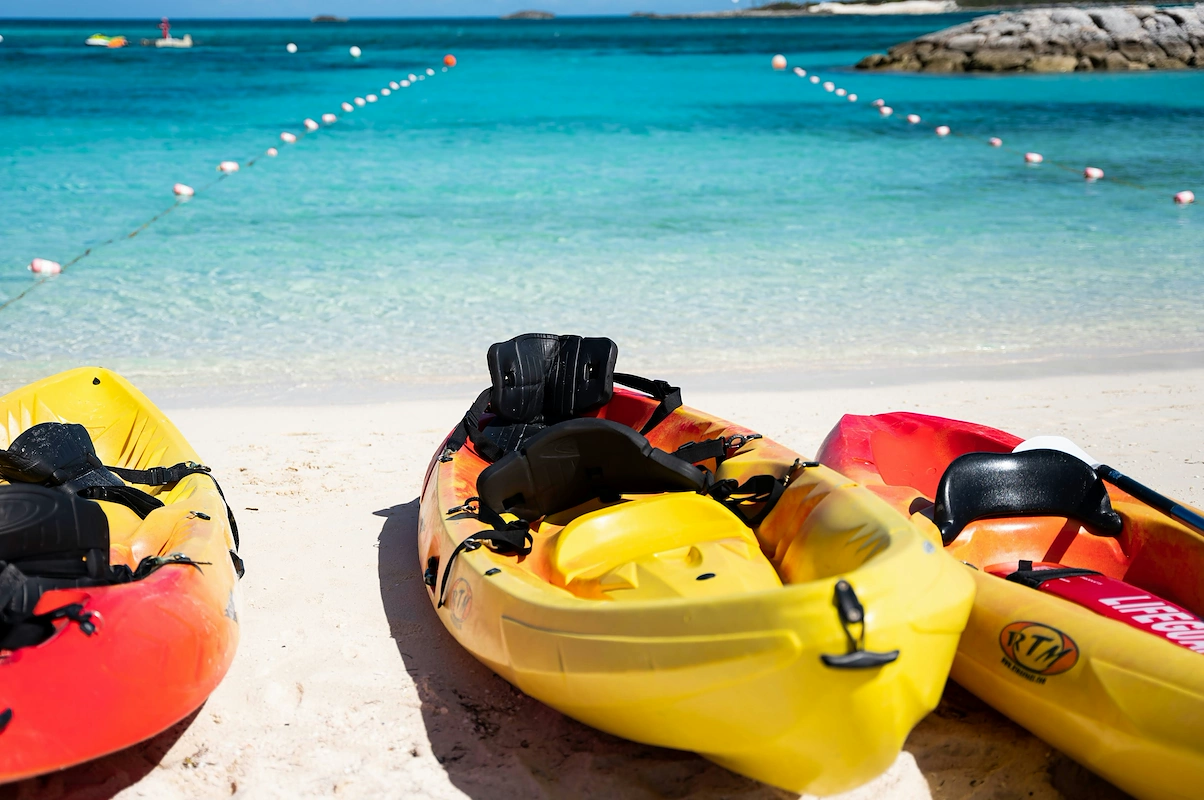Starting a jet ski rental business can be a rewarding venture, blending a passion for watersports with sharp business sense. The market is attractive because of high demand in tourist spots and a straightforward business model, but that accessibility doesn't guarantee an easy ride to success.
This guide will take you through the practical steps of selecting the right location, acquiring your fleet, securing the necessary permits, and validating your business idea to help you launch a successful jet ski rental business in the U.S.
Step 1: Plan your business and validate the idea
Research your market and competition
Start by visiting potential waterfront locations on peak season weekends. Observe foot traffic, see what existing rental services charge, and note how busy they are. This firsthand data is more valuable than any generic market report.
Next, use Google Maps to identify all competitors in a 30-mile radius. Analyze their Google reviews, especially the negative ones. Also, check their websites to understand their pricing, fleet models, and booking process. This helps you find service gaps you can fill.
Calculate your startup costs
A detailed budget is your next task. A frequent misstep is underestimating insurance, which can run from $2,000 to $5,000 per jet ski annually. You might want to get quotes from a marine insurance specialist before you commit to buying your fleet.
Here is a typical cost breakdown to get you started:
- Jet Skis (New/Used): $8,000 - $20,000 per unit for reliable models.
- Safety Equipment: $100 - $300 per ski for life vests and safety kits.
- Business Insurance: $5,000 - $15,000 annually for a small fleet.
- Permits and Licensing: $500 - $2,500 depending on your state.
A small operation with three jet skis could require a startup fund between $40,000 and $85,000. While it is tempting to buy older, cheaper skis, the maintenance costs and downtime often make them more expensive in the long run.
Here are 3 immediate steps to take:
- Get at least two commercial liability insurance quotes from marine insurance specialists.
- Create a spreadsheet listing local competitors, their prices, and top customer complaints.
- Price out a fleet of three reliable, late-model used jet skis from brands like Yamaha or Sea-Doo.
Step 2: Form your company and secure permits
Choose your legal structure
You will want to form a Limited Liability Company (LLC). This structure protects your personal assets, like your home and car, from business debts and lawsuits. It is a critical shield in a business with inherent risks.
Operating as a sole proprietorship is a common but risky shortcut. It offers zero liability protection, putting your personal finances on the line. An LLC provides that protection without the complexity of a corporation and offers pass-through taxation.
Navigate licensing and permits
Your state requires a general business license, but you will also need specific local permits. Contact your city or county clerk about a "Commercial Use Authorization" or "Waterfront Operations Permit." These can take 30-90 days to process.
Permit costs vary widely, from $500 to over $2,000. A frequent oversight is thinking a standard business license is sufficient. You must get specific approval for waterfront commercial activity from the governing parks or port authority.
While there is no single federal license for jet ski rentals, you must comply with U.S. Coast Guard regulations for safety equipment on each vessel. Also, check your state's boater education requirements, as you and your staff may need certification.
Here are 3 immediate steps to take:
- File for an LLC through your state's Secretary of State website.
- Contact your local county or city office to request an application for a waterfront vendor permit.
- Check your state's boating agency website for commercial operator education requirements.
Step 3: Secure your insurance and manage risk
Insurance for a jet ski rental is not a standard business policy. You need specialized marine insurance. Expect annual premiums to range from $2,000 to $5,000 per jet ski, so a small fleet of three could cost between $6,000 and $15,000 per year.
Key insurance policies
Your insurance package should cover several areas. Many new owners make the mistake of getting a general policy, only to find it does not cover commercial watercraft operations. Be specific about your business needs with your agent.
- Marine General Liability: This covers injuries to customers or damage to their property. A minimum of $1 million in coverage is standard, but $2 million is better.
- Commercial Property/Hull Insurance: This protects your jet skis from theft, damage, or loss. Coverage should match the replacement value of your fleet.
- Workers’ Compensation: If you hire employees, this is legally required in most states to cover on-the-job injuries.
When looking for a provider, you should seek out an agent who specializes in marine activities. General agents often miss the specific risks involved. Consider getting quotes from specialists like McGraw Powersports, Global Marine Insurance, or Pantaenius who understand the industry.
Beyond insurance, a strong liability waiver is your first line of defense. Have a lawyer draft or review your waiver to ensure it is enforceable in your state. This document, combined with a mandatory safety briefing for every rider, helps manage your day-to-day risk.
Here are 3 immediate steps to take:
- Request quotes from at least two insurance agents who specialize in marine or powersports coverage.
- Contact a local attorney to draft a comprehensive liability waiver for your customers to sign.
- Review your state's requirements for workers' compensation insurance.
Step 4: Secure your location and purchase equipment
Your location needs the right zoning, often labeled "Commercial Recreation." Before you approach a property owner, contact your local planning department to confirm a spot is eligible. This simple check prevents you from leasing a location where you cannot legally operate.
When you negotiate a lease, consider proposing a seasonal contract or a percentage-of-revenue model, around 10-15% of gross sales. This arrangement lowers your fixed costs during the off-season and can be attractive to marina or resort owners.
Essential equipment and gear
Once your location is set, you can acquire your operational gear. Many new owners focus only on the jet skis, but the supporting equipment is just as important for a smooth operation. Your budget should account for these items.
- Floating Jet Ski Ports: Expect to pay $1,500 - $3,000 per unit from brands like EZ Dock or Wave Armor. These protect your skis and make launching easier.
- Booking Software: A system like FareHarbor or Peek Pro is vital for managing reservations and waivers. They typically charge a small percentage per booking.
- Safety Kits: Budget around $150 per jet ski for USCG-approved life vests, whistles, and a compact fire extinguisher.
- Check-in Kiosk: A simple 10x10 foot shed or booth for your staff and payment processing can range from $1,000 to $4,000.
Here are 4 immediate steps to take:
- Contact your city’s planning department to confirm zoning for two potential locations.
- Draft a lease proposal offering a percentage of revenue instead of a fixed rent.
- Get quotes for three floating jet ski ports from a supplier like EZ Dock.
- Schedule demos with two booking software providers, such as FareHarbor and Peek Pro.
Step 5: Set up your payment processing
You will need a system that accepts credit cards and digital wallets. A frequent misstep is choosing a processor that cannot place a temporary hold for security deposits, which are typically $300-$500 per ski. You want a solution that can authorize, not just charge, a card.
Look for a mobile payment solution with low transaction fees and no long-term contracts. Since you will take payments at the dock, you need a system that works on a smartphone or tablet without clunky hardware. This keeps your check-in process fast and portable.
For jet ski rentals that need to accept payments on-site or on-the-go, JIM offers a streamlined solution. With JIM, you can accept debit, credit and digital wallets directly through your smartphone - just tap and done. Other providers often charge 2.5% to 3.5% plus monthly fees.
At just 1.99% per transaction with no hidden costs or extra hardware needed, it's particularly useful for handling walk-up customers right on the dock. You can get started right away.
- Get Started: Download JIM app for iOS
- Make a Sale: Type the sales amount, hit sell, and ask your customer to tap their card or device on your phone
- Access Funds: Your money is available right on your JIM card as soon as the sale is done - no waiting for bank transfers
Here are 3 immediate steps to take:
- Research two payment solutions that can place authorization holds for security deposits.
- Compare the total fees for JIM against another mobile payment processor.
- Download the JIM app to see how the interface works for your business.
Step 6: Fund your business and manage finances
Secure your startup capital
You can fund your fleet with equipment financing. Lenders who specialize in marine assets often approve loans from $30,000 to $75,000 for new businesses. Interest rates typically range from 8% to 13%, and they will want to see a strong business plan.
Another solid option is an SBA 7(a) loan, which can cover equipment and working capital. A mistake some owners make is to use personal credit cards for startup costs. The high interest rates can quickly drain your cash flow before you even launch.
Manage your working capital
You will need enough cash to cover your first six months of operation. For a three-ski fleet, plan for $15,000 to $25,000 in working capital. This covers insurance, slip fees, fuel, and initial marketing before revenue becomes consistent.
Set up a separate business bank account as soon as your LLC is formed. This simplifies bookkeeping and protects your personal liability shield. It also makes you look more professional to lenders and partners.
Here are 3 immediate steps to take:
- Contact your bank's business department to ask about the SBA 7(a) loan application process.
- Research two marine equipment financing companies and compare their terms.
- Create a six-month budget to calculate your exact working capital requirement.
Step 7: Hire your team and set up operations
Define roles and responsibilities
Your primary hire will be a Dock Attendant. This person handles safety briefings, fits life vests, and helps customers launch and dock. They also clean and refuel the skis. Plan to pay between $15 and $20 per hour, plus tips, for a reliable attendant.
All staff must have any state-required boater education cards. It is also smart to require First Aid and CPR certification, as your insurance provider may offer a discount for it. Some owners make the mistake of hiring friends without formal training, which is a significant liability risk.
Streamline your daily workflow
A good rule of thumb for staffing is one attendant for every two to three jet skis you have on the water at one time. This ratio ensures no one is rushed and safety procedures are followed. On busy weekends, you may need an extra person just for check-ins.
To manage schedules, you can use an app like Homebase or When I Work. These platforms help you build schedules, track hours, and communicate with your team from your phone. This avoids no-shows and confusion during your peak season.
Here are 3 immediate steps to take:
- Draft a job description for a Dock Attendant, including pay and required certifications.
- Check your state’s boating agency website for commercial operator training requirements.
- Create a free account on a scheduling app like Homebase to explore its features.
Step 8: Market your business and get customers
Dominate local search
Your first move is to claim and optimize your Google Business Profile. This is how over 90% of your customers will find you. Fill it out completely with your exact location, hours, high-quality photos, and a direct link to your booking page.
Some owners set up their profile and then forget it. You should actively ask every happy customer for a review. A steady flow of recent, positive reviews is the most powerful factor for ranking above competitors in local map searches.
Forge local partnerships
Once you have your online presence sorted, connect with hotel concierges and Airbnb hosts. Offer them a 10-15% commission for each booking they refer. Provide them with a simple flyer that has a QR code to your booking page to make it easy.
You can also run targeted Facebook and Instagram ads. A small budget of $20 per day during peak season can be effective. Target users who are listed as "traveling in" your location to reach tourists who are actively looking for activities.
Here are 4 immediate steps to take:
- Create and fully verify your Google Business Profile with at least 10 photos.
- Draft an email template to propose a referral partnership to three local hotels.
- Design a simple flyer with a QR code that links to your booking page.
- Set up a Facebook ad campaign targeting tourists within a 10-mile radius of your business.
Step 9: Set your pricing and profit margins
Choose your pricing model
Most jet ski rentals use a simple hourly rate, typically from $90 to $150. You can also offer tiered pricing. For example, a two-hour rental might be $220 instead of $240, which encourages longer bookings and increases your revenue per customer.
You might want to consider dynamic pricing for peak demand, increasing rates by 15-25% on holidays and weekends. Some new owners just copy competitor prices, but this overlooks unique costs like insurance and slip fees. Always calculate your break-even point first.
Calculate your profit margin
A healthy gross profit margin is between 60% and 75% before you account for fixed overhead. Your price must cover more than just the ski. Each rental hour should account for fuel ($15-$25), a maintenance fund ($5-$10), and a portion of your daily insurance premium.
With these costs in mind, you can build a pricing structure that ensures profitability. For instance, if your direct cost per rental hour is $40, a $120 price gives you a solid margin to cover rent, marketing, and other business expenses.
- Hourly Rate: The standard for walk-ups. Example: $120 per hour.
- Package Deals: A 4-hour block for $400, saving the customer $80. This encourages longer rentals and secures more revenue upfront.
- Early Bird Special: Offer a 10% discount for the first two hours of the day to get skis on the water faster and maximize daily utilization.
Here are 3 immediate steps to take:
- Calculate your break-even cost per hour for one jet ski, including fuel, insurance, and maintenance.
- Create a three-tiered pricing sheet for 1-hour, 2-hour, and 4-hour rentals.
- Decide on your holiday and weekend pricing surcharge, for example, a 20% increase.
Step 10: Launch your business and scale up
Establish your quality standards
On day one, your focus is consistency. Create a pre-ride checklist for each jet ski covering fuel levels, engine oil, and a visual inspection for damage. This simple document is your first line of defense against mechanical issues and ensures every customer gets a reliable machine.
Your customer reviews are a direct measure of quality. You should aim for a 4.8-star or higher average on your Google Business Profile. Use any negative feedback to refine your safety briefing, check-in process, or equipment maintenance schedule immediately.
Use data to guide your growth
You will want to track your fleet’s utilization rate, which is the percentage of available hours that are booked. When your fleet is booked over 70% of the time on weekends for a month straight, it is a strong signal that you have enough demand to add another jet ski.
A mistake some owners make is expanding too fast after one good weekend. Base your growth decisions on sustained demand, not a single sales spike. Once you have four or more skis, you will likely need a second dock attendant to manage check-ins and safety briefings without delays.
Here are 3 immediate steps to take:
- Create a pre-ride and post-ride inspection checklist for your staff to use on every rental.
- Set up a simple spreadsheet to track your weekend utilization rate for each jet ski.
- Decide on your hiring trigger, such as when you add your fourth jet ski to the fleet.
You have the roadmap to launch your jet ski rental business. Remember that your success hinges on the customer experience, from booking to the final wave goodbye. Focus on safety and fun, and you will build a reputation that brings people back. Your adventure starts now.
To keep that experience smooth, you need simple payments. JIM turns your phone into a card reader for a flat 1.99% fee, with no extra hardware. It helps you take payments right at the dock. Download JIM to get started.















